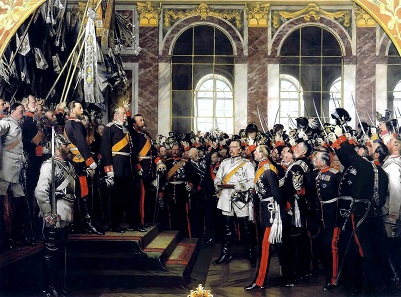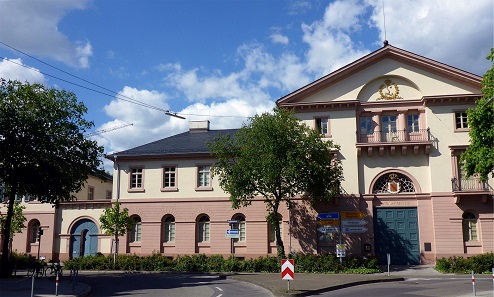February 2, 2016 – Germany has a population of almost 82 million. That’s a lot compared to France (66.03 million), or Great Britain (64.1 million). But this size of population does not justify an oversupply by five national mints. Why Germany, nevertheless, has five state-owned mints, and will probably continue to have them for a while, is summarised in this article.
William I is crowned German Emperor in 1871. Painting of Anton von Werner, 1885.
When William I was crowned German Emperor on January 18, 1871, this was a development viewed with great unease by the rulers of the rest of Germany. Traditionally, the princes of the Holy Roman Empire held sovereign rights such as jurisdiction, tax collection and, of course, the right to mint coins in their territories. Despite the crowning of a German emperor, the constituent territories were not willing to transfer all of their rights to a central government. Therefore, the newly founded nation was a patchwork of many little nations, of which each one kept a jealous watch on their privileges.
The Karlsruhe Mint still operates in the same building which was ordered to be erected by Charles I, Grand Duke of Baden, in 1816. Photo: Günter Josef Radig / CC BY-SA 3.0 de
The Imperial Mints of Germany
And one of those privileges was minting their own coins. Both the Imperial Coinage Act from 1871 and the one from 1873 determined that not one united, national mint should strike German coins, but that the mints of the constituent territories, which were willing, should take over this task. These were mainly the major states and city states: the Kingdom of Prussia, Bavaria, Saxony and Wuerttemberg, the Grand Duchies of Baden and Hesse, as well as the Free Hanseatic City of Hamburg.
In 1953 the German Democratic Republic closed the Muldenhütten mint in Saxony. Photo: Numiscontrol / CC BY-SA 3.0 de
Shortly after the introduction of the new currency, several mints were closed. Already back then, the active German mints emerged: Prussian Berlin, Bavarian Munich, Stuttgart in Wuerttemberg, Karlsruhe in Baden, and Hamburg. The only mint currently not active anymore is that of Saxon Muldenhütten, which was closed in 1953 as a GDR (German Democratice Republic) mint, when the entire coin production of the GDR was concentrated in Berlin.
The German mints after World War II
The six mints just named produced the coins of the German Empire, the Weimar Republic, and the Third Reich. When it was time – after the victory of the Allies against Nazi Germany – to introduce a new currency, it was decided to keep this system going. In West Germany all mints were kept active. A balanced system was developed, after which even today the striking of coins is subject to both the Cabinet of Germany and the federal states.
When the GDR was integrated into the Federal Republic of Germany, this system was adopted for the Berlin mint.
Legal and administrative status of the German mints
Germany is a country which has three political echelons:
- the municipal level,
- the federal states as the heirs of the former principalities
- the government, currently under Chancellor Angela Merkel.
While in many other countries the mint is directly subject to the highest financial authority, minting in Germany is divided between the federal government and the federal states, due to the above explained historical reasons.
In section 7 of the Act on the minting of divisional coins from 1950, the legislator determined the following:
7.1 Coins will be minted on behalf of and for the account of the Federal Government in the mints of the Federal States which have declared their willingness. The procedure of minting is to be controlled by the Federal Ministry of Finance;
7.3 With the approval of the Federal Council, the Minister of Finance determines the distribution of the sums to be minted to each mint and warrants a compensation for every coin type minted.
When the euro was introduced, the German Coinage Act was only slightly rephrased, improving the position of the federal government and weakening the influence of the federal states. The Act, most recently changed on December 22, 2011, stipulates the following in section 6:
6.1 The German euro coins and the German commemorative euro coins are to be minted by the mints of Federal States which declare their willingness and which are commissioned by the Federal Government. The procedure of minting is subject to oversight by the Federal Ministry of Finance;
6.2 The Federal Ministry of Finance determines the distribution of the sums to be minted to each mint and warrants an equal and adequate compensation for every coin type minted.
This means that Germany would have to change its Coinage Act in order to contract out its minting internationally.
Also, the closure of a German mint cannot be decided by the federal government, but only by the Ministry of Finance of the relevant federal state. To each federal state, the mints represent employers, partially financed by government funding, which contribute to their national product. So, as long as the state-owned German mints do not share a loss, why should any of them be closed?
These are the websites of the various German mints: Berlin (only in German), Hamburg (only in German), Karlsruhe, Munich, Stuttgart.
This article was first published in Mint News Quarterly 03 / 2016. Mint News Quarterly is issued by Currency News in association with Monea. Editor is Ursula Kampmann.







